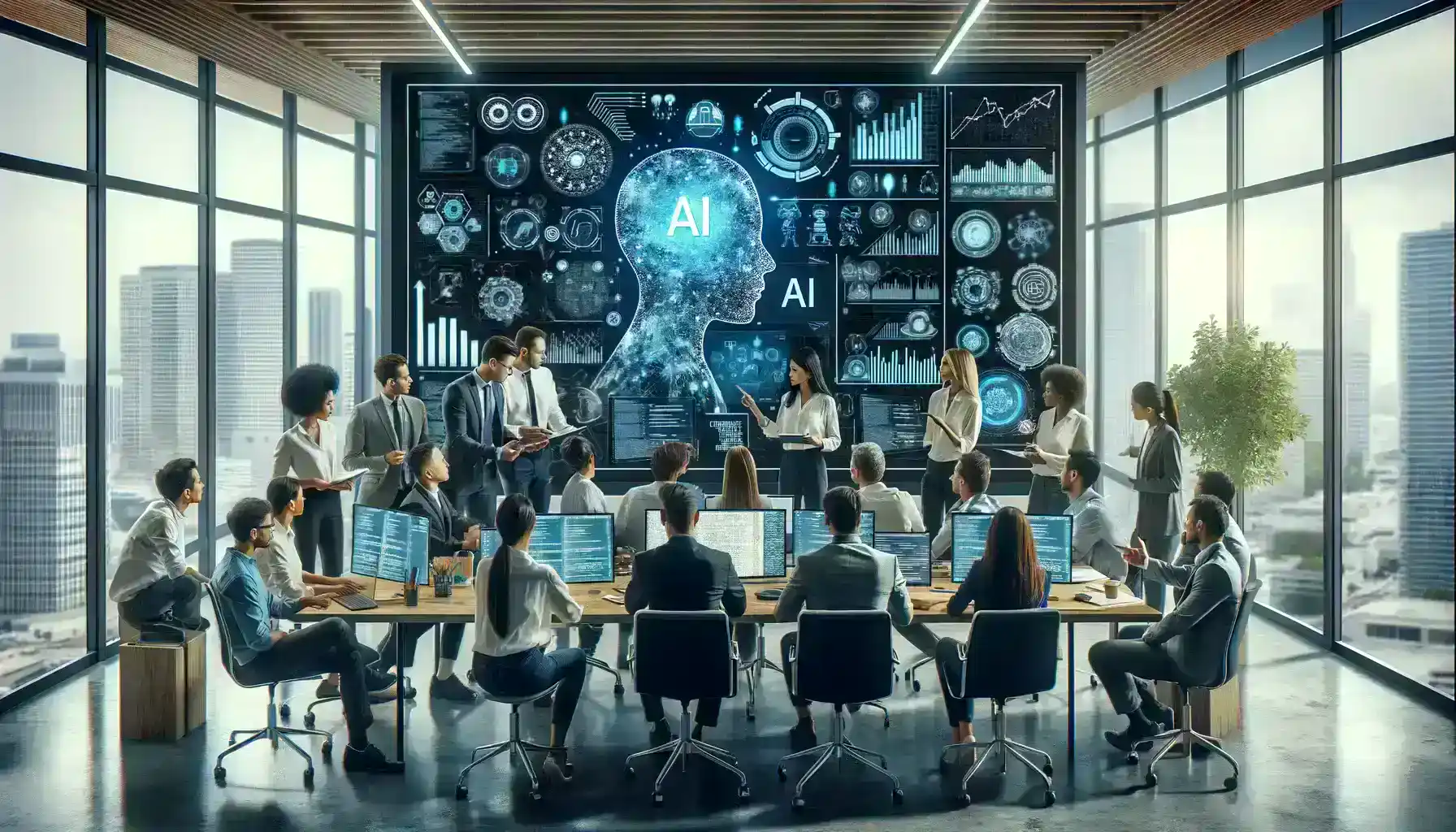Table of Contents
AI Talent Shortage
The AI talent shortage is a pressing issue characterized by a significant gap between the rising demand for skilled professionals in artificial intelligence (AI) and the limited supply of qualified individuals available in the job market. This gap is essentially a discrepancy between the requirements of businesses and organizations to harness the power of AI and the number of professionals with the necessary knowledge and expertise to fulfill these requirements.
It is characterized by a substantial gap between two critical factors: the escalating demand for skilled professionals in artificial intelligence (AI) and the limited supply of qualified individuals available in the job market.
The AI talent shortage is not just a localized problem; it’s a global challenge that affects businesses across various sectors and industries, from tech giants to healthcare institutions, financial firms, and more.
Significance of the AI Talent Shortage
- The Impact on Businesses and Organizations: The AI talent shortage holds significant implications for businesses and organizations across various industries. It’s not merely an HR concern but a critical strategic challenge. This shortage can affect a company’s ability to innovate, adapt, and compete effectively in the modern business landscape.
- Hurdles to Innovation and AI Implementation: AI talent shortage can act as a bottleneck, hindering the innovation process and slowing down the implementation of AI-driven projects.
- Staying Competitive and Relevant: Businesses that can’t harness the power of AI risk losing market share to competitors who can. They may also find it challenging to meet evolving customer expectations and industry standards.
- Proactive Strategy for Long-Term Success: Building a skilled AI team is not just a reaction to a problem but a proactive strategy for ensuring long-term success and sustainability in an AI-driven world.

Challenges of AI Talent Shortage
Incorporating these challenges into the article will convey the gravity of the AI talent shortage for shaping the future of businesses and organizations.
1. Identifying Qualified AI Professionals
- Challenge: Tesla, known for its advanced electric vehicles and autonomous driving technology, faces the challenge of identifying and hiring top-tier AI professionals to drive its AI and self-driving car initiatives.
- Solution: Tesla established collaborations with academic institutions and research centers to tap into the expertise of professors and researchers. This helped identify emerging talent in the field. Tesla encouraged its current AI professionals to actively participate in AI conferences, workshops, and communities.
- Tesla’s approach to identifying qualified AI professionals has been successful in building a talented AI team. By using a combination of focused recruitment, technical assessments, practical interviews, collaboration with academia, and industry involvement, Tesla has been able to attract and retain top AI talent to drive its autonomous driving and AI projects.
2. Attracting Top AI Talent
- Challenge: Facebook AI Research (FAIR) is dedicated to advancing artificial intelligence’s state-of-the-art through open research collaboration. FAIR faces the ongoing challenge of attracting and retaining top AI researchers and engineers in a highly competitive field.
- Solution: FAIR emphasizes its commitment to cutting-edge research and the opportunity for researchers to work on groundbreaking projects with real-world impact.
- Facebook AI Research (FAIR) has successfully attracted and retained top AI talent by offering an appealing work environment that prioritizes cutting-edge research, collaboration, and global reach. As a result, FAIR has made significant contributions to the field of AI and machine learning.
3. Bridging the AI Skills Gap
- Challenge: Facebook AI faced the challenge of addressing the AI skills gap in the broader AI community. The rapid evolution of AI technologies meant that many developers and researchers needed to upskill to keep pace with the latest advancements.
- Solution: Facebook AI launched the PyTorch initiative, an open-source deep learning framework that simplifies the development and deployment of AI models. PyTorch was designed to be user-friendly and accessible to developers with varying levels of AI expertise, making it an ideal tool for those looking to enter the AI field or upskill.
- Facebook AI’s PyTorch initiative played a pivotal role in bridging the AI skills gap by providing accessible tools, educational resources, and a thriving community for AI enthusiasts and professionals. It empowered individuals to acquire AI skills, participate in research, and contribute to the advancement of AI technology.

4. Dealing with High Employee Turnover
- Challenge: NVIDIA, a leading technology company specializing in graphics processing units (GPUs) and AI technology, faced a common challenge in the tech industry: high employee turnover, particularly among AI engineers. The competitive AI landscape meant that top AI talent was in high demand.
- Solution: The company fostered a supportive and collaborative work environment where engineers could freely exchange ideas, solve complex challenges, and learn from each other. This culture of collaboration contributed to higher job satisfaction.
- NVIDIA’s retention strategies effectively reduced turnover rates among its AI engineers. By offering exciting projects, supporting continuous learning, providing competitive compensation, creating a supportive work environment, and offering opportunities for career growth, NVIDIA retained top AI talent and continued to lead in the AI hardware and software industry.
5. Overcoming Geographical Limitations
- Challenge: Automattic, the company behind WordPress.com and other web-related products, faced a challenge in attracting AI talent. Their workforce was highly distributed, with employees scattered around the world. While this distributed model allowed them to tap into a diverse range of skills and perspectives, it also presented challenges when hiring specialized AI professionals.
- Solution: Automattic embraced its distributed workforce model and leveraged it to overcome geographical limitations in the search for AI talent. They actively recruited AI experts who were passionate about remote work and could collaborate effectively from anywhere in the world.
- By focusing on remote-friendly AI professionals, Automattic successfully built an AI team with members from various countries. This approach allowed them to access AI talent that might have been otherwise out of reach due to geographical constraints.

6. Ensuring Diversity and Inclusion
- Challenge: IBM, a global technology company heavily involved in AI research and development, recognized the lack of diversity in the AI field as a pressing challenge. Like many tech companies, IBM’s AI teams were often homogenous, lacking representation from various backgrounds and demographics.
- Solution: IBM actively promoted diversity in its hiring processes. They implemented strategies to attract talent from diverse backgrounds, including historically underrepresented groups in tech, and ensured that their hiring practices were free from bias.
- IBM’s commitment to diversity and inclusion in AI teams resulted in more diverse and representative research and development efforts. Their research projects and AI systems were better equipped to address the needs of a broader range of users and communities.
7. Managing AI Team Dynamics
- Challenge: Microsoft’s AI for Good initiative focuses on using artificial intelligence to address some of the world’s most pressing challenges, such as environmental sustainability, healthcare, and accessibility. The initiative involves teams of AI professionals working on diverse and interdisciplinary projects.
- Solution: Microsoft encouraged cross-disciplinary collaboration among team members, including AI researchers, domain experts, and project managers. This approach ensured that diverse perspectives were considered in problem-solving.
- Microsoft’s AI for Good initiative successfully managed diverse AI teams working on projects with significant societal impact. By fostering cross-disciplinary collaboration, adopting agile development practices, promoting effective communication, empowering innovation, and facilitating global collaboration, Microsoft was able to drive meaningful progress in addressing global challenges through AI.
These challenges and solutions offer a comprehensive framework for addressing the AI talent shortage and supercharging your team for success.
Conclusion
In the ever-evolving landscape of technology and innovation, the demand for AI talent continues to soar, creating a noticeable gap between the need for skilled professionals and their availability. This phenomenon, known as the “AI talent shortage,” is a challenge that businesses and organizations worldwide are grappling with.
Throughout this article, we’ve explored the multifaceted dimensions of this challenge and presented concrete solutions to empower you in conquering it. We’ve delved into the intricacies of identifying qualified AI professionals, attracting top talent in a competitive market, and bridging the AI skills gap through continuous learning.
As you navigate the AI talent shortage landscape, remember that your organization’s ability to assemble a skilled AI team is a critical determinant of its future success. By implementing the strategies and solutions discussed in this article, you’re not only bridging the talent gap but also positioning your organization to thrive in an era where AI plays an increasingly pivotal role in shaping industries and driving innovation.
The AI talent shortage is a challenge, but it’s a challenge that can be met with determination, strategic thinking, and a commitment to nurturing the AI talent that drives progress and innovation. Embrace these strategies, stay adaptable in the face of change, and continue to evolve with the ever-expanding world of AI. Your journey to supercharge your team and conquer the AI talent shortage is a journey toward a future of boundless success.